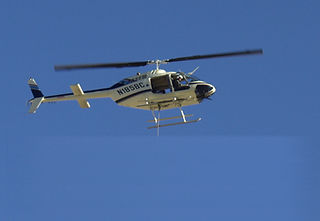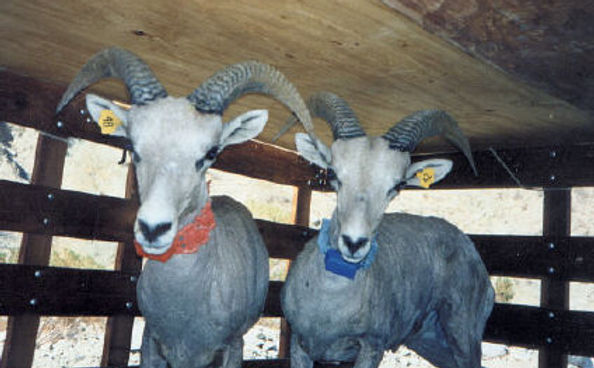Current Research Projects
PRECIOUS CARGO: Two yearling Peninsular bighorn rams in transport to a release site in the northern Santa Rosa Mountains
CAPTIVE BREEDING AND WILD POPULATION AUGMENTATION: Conservation biologists consider captive breeding an effective tool for rescuing populations threatened with extinction or delaying extinction while the agents of a decline are investigated. Since 1985, Bighorn Institute has maintained a captive population of endangered Peninsular bighorn sheep to provide animals for release into the wild. To date, a total of 127 Peninsular bighorn sheep born or rehabilitated at Bighorn Institute have been released into the northern Santa Rosa or San Jacinto Mountains. Institute biologists also study the captive herd to gather information on reproduction, maternal care, lamb development, behavior, nutrition, disease exposure and immunology.

BIGHORN DISEASE RESEARCH: Bighorn Institute regularly conducts disease screening testing of captive and free-ranging bighorn sheep to monitor bighorn health and disease exposure levels. Although disease is currently not a widely operating limiting factor for Peninsular bighorn sheep, regular monitoring can aid early detection and correction of disease concerns.
BIGHORN SURVEYS: Since 1983, Bighorn Institute has conducted annual helicopter surveys of Peninsular bighorn sheep in the Santa Rosa and San Jacinto Mountains. These surveys allow us to estimate the population's size, trend, age and sex structure, distribution, and long-term dynamics. Bighorn Institute now assists the California Department of Fish and Wildlife in conducting helicopter surveys every other year.
SAN JACINTO MOUNTAINS BIGHORN ECOLOGY: In 1969, the California Department of Fish and Wildlife estimated there were approximately 80 adult bighorn in the San Jacinto Mountains. Bighorn Institute started monitoring this herd in 1992 and found that the bighorn population had drastically declined to approximately 19 adult bighorn. We began long-term field studies of radio-collared bighorn in this range. We are evaluating the habitat use, reproduction, survival, mortality and general ecology, health and behavior of these animals. There are now approximately 75 adult bighorn in this range, with around 40 adult ewes. This herd got down to just 4 ewes in 2002, but with the Institute's augmentation efforts, the number of ewes has increased significantly and recovery is now underway.
SANTA ROSA MOUNTAINS BIGHORN ECOLOGY: One of our primary study areas is the northern portion of the Santa Rosa Mountains near Rancho Mirage, where the Institute has been monitoring Peninsular bighorn since our inception in 1982. Radio-collared bighorn in this range are regularly observed to document their home range, habitat use, diet, reproductive success, survival rates and general ecology. In the early 1980's this subpopulation was estimated to number approximately 65 adult bighorn, and hit a low of 24, but today recovery is underway as there are currently approximately 140 adult bighorn in this range.
BIOLOGICAL SERVICES: Bighorn Institute provides ecological information related to bighorn sheep to various organizations and government departments to promote the proper management and conservation of bighorn sheep. Institute researchers have been called into ten western states, and the countries of Mexico, Mongolia and Turkmenistan to assist with wild sheep projects.
_edited.jpg)

Previous Research Projects
LAMB ECOLOGY IN THE NORTHERN SANTA ROSA MOUNTAINS: The bighorn subpopulation inhabiting the northern Santa Rosa Mountains has experience unusually low lamb survival since 1977. In the spring of 1998, the Institute initiated a four-year cause-specific lamb mortality study. Thirty-four lambs were captured and radiocollared then intensely monitored to determine their habitat use, nutritional levels, disease exposure, nursing rates, survival rates and causes of death. This study has been completed and the results will help develop management recommendations for reducing lamb mortality.
ASSESSING THE USE OF CAPTIVE-REARED BIGHORN FOR AUGMENTING DECLINING DESERT BIGHORN SHEEP POPULATIONS: This project is designed to evaluate our Captive Breeding and Wild Population Augmentation Program for declining bighorn sheep populations. The assessment examined various aspects of Bighorn Institute’s current program, such as breeding arrangements, release sites, release group size, and habitat conditions. We compared the survival, recruitment, home range, habitat use and diet quality of captive-reared released and wild-reared bighorn sheep in the northern Santa Rosa Mountains. Bighorn Institute conducted this project in cooperation with the California Department of Fish and Game, Oregon State University and Anza-Borrego Desert State Park.
SICK PENINSULAR BIGHORN LAMBS RESCUED AND REHABILITATED AT BIGHORN INSTITUTE: Thirty-nine sick Peninsular bighorn lambs were captured from throughout California's Peninsular Ranges and brought to Bighorn Institute for study and treatment. Each lamb required up to a month of intensive, around-the-clock care. Obtaining biological samples from sick bighorn enabled Institute biologists to study the disease process in bighorn sheep, while rehabilitating sick lambs for release back into the wild.

